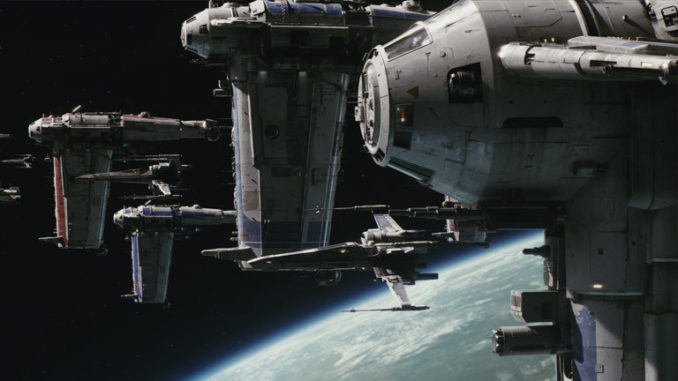
Welcome to the HoloNet Uplink, citizen. This series focuses on Fantasy Flight Games’ Star Wars Roleplaying Game, with content aimed mostly at the Gamemaster. Threats, adventure seeds, rules supplements, and more are all to come for those who access The HoloNet Uplink.
*This The Last Jedi inspired post is spoiler free, but contains information about a ship appearing in that film.*
Another movie means more content to tackle. That’s good, because there is a lot to draw upon and an injection of new material is always inspiring. But it is also a challenge, as we don’t yet have a ton of sources to draw upon. Today’s piece of content is the Resistance Bomber, which I am taking on with The Last Jedi Visual Dictionary and a single viewing of the movie as my sources. As such, please hit me up in the comments with suggestions and corrections should I have missed anything or interpreted anything from my viewing incorrectly!
MG-100 StarFortress “Resistance Bomber” SF-17
During the close of the Galactic Civil War, the New Republic needed a vessel to crack the fortress worlds of stubborn Imperial holdouts. The MG-100 StarFortress was the answer, armed to the teeth with a massive payload of 1048 proton bombs capable of shattering the most reinforced defenses. In the peace that followed, the New Republic greatly downsized its fleet of these offensive weapons. Numerous demilitarized variants were developed for use in cargo hauling, wildfire fighting, mining, survey, and other fields.
By the rise of the First Order, the Resistance scraped up mere tens of these bombers to form the understrength Cobalt and Crimson squadrons. These bombers were sourced not only from sympathetic military and industrial concerns, but more often through re-militarizing utilitarian variants. While not specifically designed for anti-capital combat, the Resistance’s courageous bomber crews developed high risk tactics to take on the ponderous destroyers and dreadnoughts deployed by the First Order. Many of the Resistance’s bombers once flew missions against the last of the Empire’s tyrannical forces, with Resistance crews adding new battle honors to the proven craft.
Sil 4; Speed 3; Handling -2; Def 2/-/-/1 Armor 4
Hull Trauma 28; System Strain 18
Hull Type/Class: Heavy Bomber/MG-100 StarFortress SF-17.
Manufacturer: Slayn & Korpil.
Hyperdrive: Primary: Class 2, Backup: Class 12.
Navicomputer: Yes.
Sensor Range: Short.
Crew: One pilot, two gunners, one bombardier, and one flight engineer.
Encumbrance Capacity: 50.
Passenger Capacity: 0.
Consumables: One months.
Price/Rarity: 225,000 credits (R) / 7
Customization Hard Points: 1.
Weapons: Quad forward-mounted medium laser cannons (Fire Arc Forward; Damage 6; Critical 3; Range [Close]; Linked 3), rear turret-mounted twin medium laser cannons (Fire Arc Aft, Damage 6; Critical 3; Range [Close]; Linked 1), dorsal turret-mounted twin medium laser cannons (Fire Arc All; Damage 6; Critical 3; Range [Close]; Linked 1), ventral turret-mounted twin medium laser cannons (Fire Arc All; Damage 6; Critical 3; Range [Close]; Linked 1), ventral-mounted bomb bay partial drop – can only be used against static or slow moving targets (Fire Arc Down; Damage 12; Critical 2; Range [Close]; Blast 8, Breach 8, Limited Ammo 6, Linked 3, Prepare 2, Slow-Firing 1, Vicious 2).
Additional Rules: Deadly Payload (Critical Hit rolls against this vehicle add +20 to the result if bombs are loaded), Magazine Dump (The bombardier may use the partial drop weapon profile above or drop all bombs at once. The GM should narratively determine the results of this drop, but it should be suitably catastrophic to whatever target is hit).
Variant: MG-100C StarMaster Cargo Dropcraft
Under the peace of the Galactic Concordance, the New Republic had little use for a heavy bomber. Many MG-100 StarFortress bombers were phased out of service and sold as demilitarized utility ships. One popular variant was the MG-100C StarMaster Cargo Dropcraft. The design repurposed the tall bomb bay and magnetic racks into a cargo delivery system for austere logistics. Hardened cargo containers affixed with repulsors, or even low-tech parachutes, could be quickly dropped in flight removing the need to land. This allowed for rapid cargo deployment and removed the need for landing pads or unloading equipment making the StarMaster a cargo craft of choice for remote colonies in extreme terrain, and even saw limited military use as a special operations logistics craft.
To represent the MG-100C StarMaster, use the statistics above with the following adjustments:
- Change the crew entry to: One pilot, two gunners, one loadmaster, and one flight engineer.
- Increase Encumbrance Capacity to 180, Passenger Capacity to 2, and Consumables to two months.
- Reduce Price to 170,000 credits, and remove Restricted.
- Remove the ventral-mounted bomb bay weapon profile, and remove both Additional Rules.
